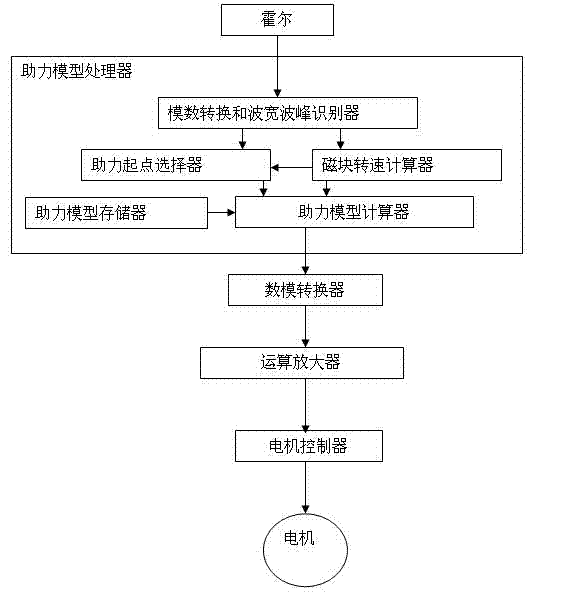Rotary table type sensor provided with magnetic blocks with adjustable positions and magnetic fluxes for booster bicycle
A technology for assisting bicycles and magnetic flux, which is applied in the direction of instruments, power metering, vehicle components, etc., and can solve problems such as unstable motor operation, no control signal, and inconsistency
- Summary
- Abstract
- Description
- Claims
- Application Information
AI Technical Summary
Problems solved by technology
Method used
Image
Examples
Embodiment 1
[0119] Embodiment 1, a turntable sensor with adjustable multi-magnetic block positions and magnetic fluxes for power-assisted bicycles
[0120] Such as figure 1 , 3 , the sensor in this embodiment includes a sensor element connected in sequence, a booster model processor 21, a digital-to-analog converter 27 and an operational amplifier 28;
[0121] [1] The sensing element is an element that converts the rotational motion of the rotating disk 1 into a rectangular wave signal output;
[0122] The sensing element is to use a high-strength plastic rotating disk 1 with a diameter of 10.0 cm to set 20 permanent magnets 2 with a diameter of 0.8 cm on one surface, and the magnetic flux is 146---279 (B·H)max / KJ·m -3 Different selection values within the range, and the magnetic flux of adjacent permanent magnet block 2 is not equal. The structure of rotating disk 1, permanent magnet block 2 and Hall 3 is as follows:
[0123] Each permanent magnet block 2 is fixed in the circular ...
Embodiment 2
[0140] Embodiment 2. A multi-magnet position and magnetic flux adjustable turntable sensor for high-density power-assisted bicycles
[0141] Such as figure 2 , 3 1. A high-strength aluminum rotating disk 1 with a diameter of 10.0 cm is provided with 40 permanent magnet blocks 2 with a diameter of 0.6 cm. The magnetic flux of the permanent magnet block 2 is 146---279 (B·H)max / KJ·m -3 Different selection values within the range, and the magnetic flux of the adjacent permanent magnet block 2 is not equal, Hall 3 keeps a distance of 0.2 cm from each permanent magnet block 2 in the rotating state, so that each permanent magnet block 2 that is rotating Hall 3, Hall 3 can generate a corresponding rectangular wave signal output. Other structures are the same as in Embodiment 1.
Embodiment 3
[0142] Embodiment 3, a turntable sensor with adjustable multi-magnet positions and magnetic fluxes for power-assisted bicycles with specific circuits
[0143] Such as figure 1 , 4 , the sensor in this embodiment includes a sensor element connected in sequence, a booster model processor 21, a digital-to-analog converter 27 and an operational amplifier 28;
[0144] [1] The Hall 3 in the sensing element is UGN3075; the structure of other elements and elements in the sensing element is the same as that in Embodiment 1;
[0145] [2] The auxiliary model processor 21 selects the single-chip microcomputer 31 to complete all functions, and the single-chip microcomputer 31 selects AT89S52. That is, the AT89S52 single-chip microcomputer 31 completes all functions of the analog-to-digital conversion and the wave width peak recognizer 22 , the power-assisted starting point selector 23 , the magnet speed calculator 24 , the power-assisted model memory 25 and the power-assisted model calc...
PUM
 Login to View More
Login to View More Abstract
Description
Claims
Application Information
 Login to View More
Login to View More - R&D Engineer
- R&D Manager
- IP Professional
- Industry Leading Data Capabilities
- Powerful AI technology
- Patent DNA Extraction
Browse by: Latest US Patents, China's latest patents, Technical Efficacy Thesaurus, Application Domain, Technology Topic, Popular Technical Reports.
© 2024 PatSnap. All rights reserved.Legal|Privacy policy|Modern Slavery Act Transparency Statement|Sitemap|About US| Contact US: help@patsnap.com










